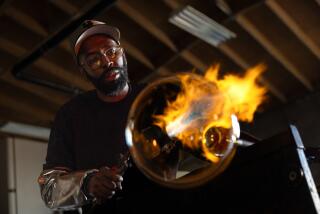A Glass Act : Elegant, Handblown Goblets and Tumblers Give the Dinner Table a Dash of Color
- Share via
Crystal may wink at you from across the room, but sometimes the stylish host or hostess wants something with a bit more pizazz. These days, fashionably dressed dinner tables are aglitter with handblown colored glassware designed in a medley of shapes and patterns.
“Colored glasses are like jewelry for the table,” says Steven Reissman, owner of the Tesoro Collection in Los Angeles, a store specializing in decorative accessories. A lot of customers buy the beautiful tumblers and wineglasses as bridal gifts, Reissman says, then keep them for themselves. His glass sales have quadrupled since 1987.
“People are looking for a little color in their lives,” says Carol Sauvion of Freehand, another local gallery. “There’s also this attraction for the handmade object. It just feels good in your hand.”
Handblown glass is gaining as much popularity with artists as it is with consumers. A seductive medium, it lures more and more California creative types from other disciplines every year. “It’s melting and hot,” says textile artist Tim Veness. “It’s soft but not so soft that it runs away with you. It challenges you on a lot of different levels. You use your whole body. You just get hooked.” Veness, who currently teaches weaving at the Penland School of Arts in North Carolina, took a glass-blowing course three years ago and became enraptured. Now he creates colored tumblers shaped with swirling lines that echo his fabric’s weave.
The art of glass blowing has changed little since its development about 2,000 years ago. To make glass, silica (sand) is mixed with soda and lime and melted in a furnace until it is a syrupy mass. Oxides are added to make different colors: Cobalt oxides create an intense blue glass, gold and copper oxides produce red glasses. Then, as now, a metal pipe is dipped into the molten glass. The artist blows gently into the pipe until the glass bulges out to form a hollow tube. At this stage, the molten glass can be stretched, pinched, twisted and cut with pincers, jacks and diamond shears to create a variety of shapes and patterns. Paul Counts, another glass-blowing devotee, says it’s like “trying to control a hot blob of honey on the end of a four-foot stick.”
There are hundreds of techniques for getting different textures and colors in glass. One way to make textured glass is to blow the molten glass into a mold, usually made of aluminum. But there really are no set rules. To make more organic shapes, artists blow glass into wet newspaper. To get a multicolored effect, the blower builds the glass from the inside out.
Counts, who teaches glass blowing at Orange Coast College, began school as a premed student. “I always thought I would be a pediatrician,” he says, but he took a glass-blowing class, “and the first time I made a funky shape, I was hooked.”
Counts specializes in one-of-a-
kind ceremonial goblets. “I like the idea of a precious vessel that is used only once in a while. People can make their own special ceremonies--not just weddings or anniversaries: It can be anything: a divorce; a new baby; it’s Friday.” It takes him six minutes--and 12 years of experience--to blow one of his colored tumblers.
Mass-produced products have no individuality, he says, but each piece of making handblown glass is unique. “No one else can have exactly the same one,” he
says. “It’s your own personal treasure.”





